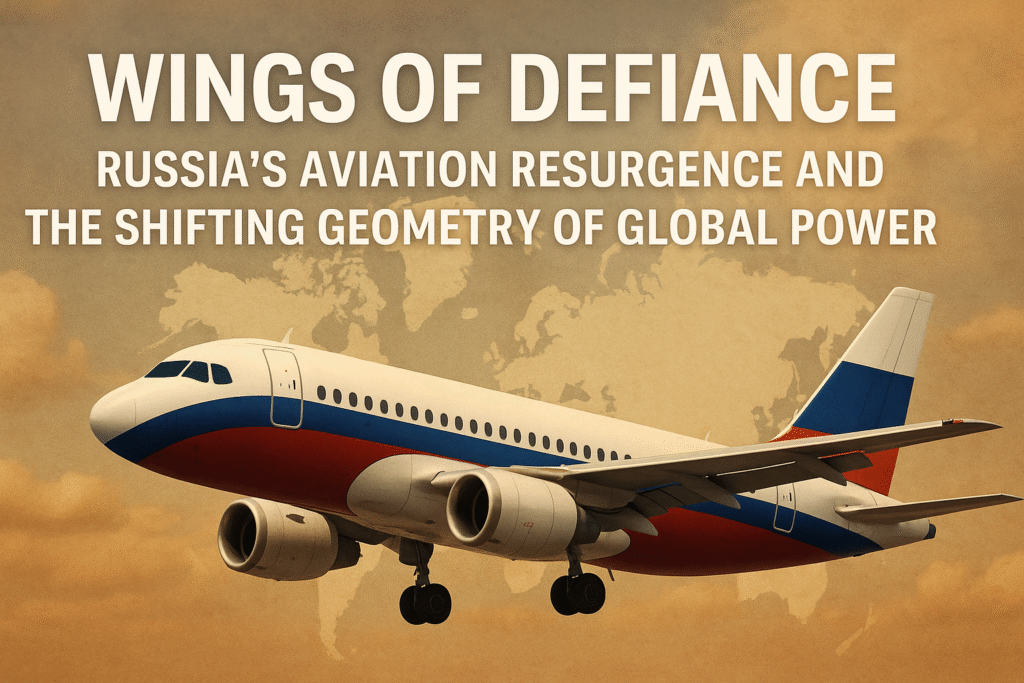In the rarefied corridors of global aviation, a silent revolution is unfolding one that could reshape not just the industry but the architecture of international politics.
Russia, long battered by sanctions and isolated from Western technology, has chosen not retreat but to renaissance. Its latest moves in aviation from reviving indigenous jet programmes to courting strategic partners like India’s Hindustan Aeronautics Limited (HAL) go far beyond economic survival. They represent an audacious proclamation of sovereignty in a polarized world.
A Flight from Dependency: Moscow’s New Doctrine
When Western sanctions clipped the wings of Russia’s aerospace supply chain after the Ukraine invasion, stagnation seemed inevitable. Yet Moscow, stoic in adversity, crafted a response that blends technological nationalism with strategic pragmatism.
Projects such as the MC-21 airliner and Sukhoi Superjet New now embody its determination to purge Western components. Engines like PD-14 and PD-8 replace imported systems, signaling a shift from reliance to resilience.
This is more than an engineering pursuit — it is economic geopolitics in motion. By nationalising the core of its aviation ecosystem, Russia seeks to turn isolation into insulation. Sanctions, once coercive, have become catalysts of self-reliance. The message resonates across the Global South: autonomy is resistance.
HAL and the Reawakening of a Dormant Partnership
India’s HAL stands at a crucial junction in this evolving story. The historical camaraderie between Moscow and New Delhi marked by decades of MiG and Sukhoi collaborations had slowed in recent years. Now, shifting global alignments have rekindled this long-dormant alliance.
Reports suggest renewed cooperation in spare-part production, engine servicing, and advanced combat aircraft upgrades. Even the shelved dialogue on a joint fifth-generation fighter has quietly resurfaced.
For HAL, this presents both opportunity and challenge. The partnership enhances India’s defence-industrial credibility but also requires diplomatic finesse. New Delhi must ensure that cooperation with Moscow complements, rather than complicates, its growing ties with the West.
Washington’s Uneasy Gaze and Echoes of a Cold War Past
Across the Atlantic, Washington watches uneasily. Despite deepening defence coordination with India under frameworks like QUAD and I2U2, the United States views Delhi’s closeness to Moscow as a strategic puzzle.
Yet India’s foreign policy follows a different compass strategic autonomy, not alignment. It is a delicate dance between multiple poles of power, a modern reimagining of Nehru’s non-alignment. In this new order, multi-alignment serves national interest, not ideology.
For the U.S., Russia’s aviation pivot presents a subtler threat. If Moscow builds an alternative aviation ecosystem with Asian partners, it could weaken Western aerospace monopolies. The Boeing–Airbus duopoly, once unchallenged, might soon face competition in a multipolar sky.
Beyond the Runway: The Geopolitical Undercurrents
At its core, Russia’s aviation revival is not about aircraft it is about agency. It reflects a refusal to let sanctions dictate destiny. By fostering ties with India, China, and Iran, Moscow is weaving a new fabric of cooperation across Eurasia one resistant to Western control and rich in technological exchange.
This shift marks a deeper transition from dependence to deterrence, from compliance to assertion. The aviation sector, once a neutral space of innovation, has turned into a geopolitical arena. Supply chains are now frontlines, and turbines symbols of power.
India’s Balancing Act: Between East and West
India once again plays the tightrope walker of geopolitics. While Russia remains a trusted defence ally, the United States and France are vital to its future aerospace ambitions. HAL’s renewed dialogue with Moscow, therefore, must be read as calibration, not tilt.
India’s diplomacy rests on the ability to engage both blocs without surrendering to either. In a world that grows increasingly binary, this sovereign latitude defines India as a civilizational state navigating a transactional century.
Implications: The Sky as a Strategic Theatre
If the partnership deepens, Indo-Russian co-production could see a new dawn from fighter engines to unmanned aerial systems. Yet turbulence remains ahead. Russia’s technological ecosystem, though resilient, faces limits from chip shortages to financial fatigue.
India, meanwhile, must ensure that cooperation fuels indigenous innovation, not dependency. Every rivet fixed in a Russian factory could send tremors through Western aerospace circles. Every HAL–Russia handshake signals a subtle truth the skies are no longer the exclusive domain of transatlantic giants.
Conclusion: Flight as a Metaphor for Power
In geopolitics, aviation has always symbolized more than technology it mirrors national will. Russia’s latest aviation gambit, with India as a potential co-traveller, is an assertion of that will against Western gravity.
Whether this venture ascends or falters remains uncertain. Yet one fact endures: in the new global order taking shape above the clouds, sovereignty has grown wings.
MiG-21 Retirement 2025 & Tejas Fighter Jets: India’s Air Force Future
https://newsarmour.com/mig-21-retirement-2025/
Sources
https://economictimes.indiatimes.com/industry/transportation/airlines-/-aviation/russia-ready-to-offer-high-tech-localized-production-in-civilian-aircraft-sector/articleshow/105674004.cms The Economic Times
https://www.ruaviation.com/news/2023/2/15/18247/ ruaviation.com
https://sputniknews.in/20250310/russia-keen-to-expand-technological-cooperation-under-make-in-india-8850463.html sput





